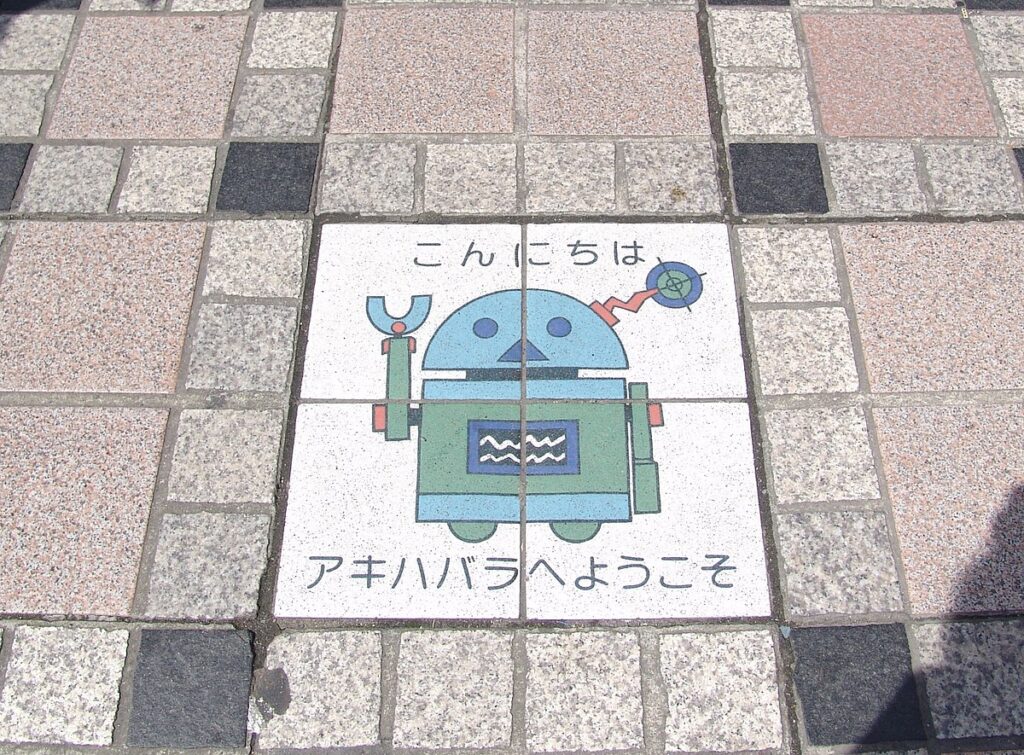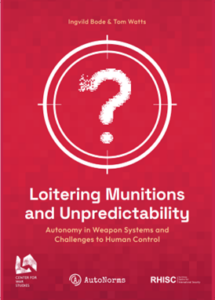Imagine that you are sitting in a restaurant somewhere in central Tokyo. You have just ordered your lunch using the tablet provided. Suddenly, coming from the direction of the kitchen, you hear a jingle playing. Next, a little white robot turns the corner and drives in your direction. As it comes closer, you see that its front display shows a stylised, kawaii cat face. Beyond that, the main parts of its design feature four levels of trays where the kitchen staff can place dishes. The robot keeps chattering on its way through the restaurant. As it comes closer, your table number pops up on the display. The robot then proceeds to swivel around, allowing you to take your dish from its tray. Its task completed, it swivels around, and drives away while continuously playing its jaunty jingle, eventually disappearing through the kitchen door.

What I have just described appears to confirm expectations of ‘futuristic’ daily life in Japan circulating across various media outlets. Beyond regular reporting on earthquakes, the aftermath of the Fukushima disaster, or North Korean missile tests, Japan-related reports featuring some kind of ‘social robot’ or a robot in social settings have a high likelihood of reaching European audiences. In academic writing across social science disciplines, many contributions start from the persistent assumption that the Japanese public has a more positive attitude towards robots when compared to European publics, for example, Germany. But is this really the case? I address this question by offering an overview of the academic literature on cultural perceptions of robotics and artificial intelligence (AI)-associated technologies. This is followed by reflecting on what is at stake when considering such questions in the context of the growing debate about applications of robotics and AI in the military domain. My reflections are also based on impressions gained during a research stay at the University of Tokyo (December 2023 – January 2024).
Let me start with briefly reflecting on how robotics and AI connect. AI is a problematic, politically charged term that I consider broadly, following Timnit Gebru, as “the effort to create machines or things that can do more than what is programmed into them”. The development of robotics and AI is certainly distinct: robotic systems often rely on forms of AI, autonomous, or automated technologies (in other words, forms of algorithms), while AI technologies describe forms of software that may or may not be integrated into a robotic system. In the military domain, for example, we can think of AI technologies both as part of robotic, weapon systems but also as functioning in decision-support systems that are not part of any robotic system with sensors and actuators. Autonomous weapon systems (AWS) combine software and hardware components to fulfil the three key functions of perception, cognition, and actuation. There is therefore some technological overlap between robotics and AI, as well as some degree of public association. The latter can also be connected to how the visual language of AI heavily (but inaccurately) relies on humanoid robots.
Japanese ‘robot culture’
Japan has become associated with the imaginary of being a ‘robot culture’ since the 1980s. Such associations are based on a two-fold argument: first, in the 1980s, Japan dominated the market in industrial robotics, with numbers of industrial robots in service far exceeding those in Europe or the US. Japanese automobile manufacturers, such as Honda, have long been leading developers of industrial robotics. But robots were not only used by the big players, but also by many small and medium businesses. This greater usage of robots also became apparent beyond industry, including sectors such as (elderly) care and services. This has come alongside persistent research interest in developing so-called soft, humanoid robotics.
Second, Japan came to be seen as a consumer culture that is ‘uniquely’ adaptive and receptive of robots. Scholars have examined spiritual grounds for a supposed Japanese affinity to robots that may be rooted in the animist beliefs of Shinto as well as Buddhist teaching about the interconnectedness of animate and inanimate beings.
For the most part, though, this argument looks towards Japanese popular culture. In comparison to the dystopian Frankenstein associations that accompany robots in Western popular culture, benign depictions of robots as friends/allies supposedly abound in the Japanese genre of robot manga and anime. Two prominent types of robot stories are often used as examples. There is tetsuwan atomu (Mighty Atom, referred to as Astro Boy in the West), who is first featured in a 1952 manga. Atom is a school-aged android boy who lives a normal life in a human family while also fighting various threats to humans in the form of monsters, criminals, and evil robots. Sources mention Atom as the source of inspiration for Japanese roboticists and therefore the origin of Japanese interest in humanoid robotics.
A complementary, opposing popular culture narrative that has likewise enjoyed great popularity features so-called super robots, remote-controlled giant anthropomorphic machines such as the 1956 tetsujin 28 (Iron Man No. 28). These robots are “tools for human heroes” and therefore neither good nor bad—they are just machines.
While it may appear anecdotally interesting to assume a ‘positive’ Japanese stance towards robotics, variously designed empirical studies have not reached any conclusive results. In fact, many show practically no significant differences in cultural attitudes between Europe and Japan when it comes to robots. Information gained from conversations with AutoNorms research participants in Japan underlines this. Some shared stories about how generational differences mediated interactions with robots in social settings that are reminiscent of how such interactions may play out in Europe. My 4-year-old son was certainly more excited and nonchalant about being served his pancakes by a ‘robot waiter’ than his Millennial parents. Other research participants noted that, while iconic, the famous Atom can hardly be taken as representative of how robots and AI are imagined in current Japanese manga and anime. Of course, popular culture has moved on since the 1950s and now also features many dystopian imaginings. Research participants referred to the Evangelion Unit-03 of the popular 1990s robot anime Neon Genesis Evangelion as one example.
On top of this, there appears to be a degree of techno-orientalism at play in assuming a Japanese ‘robot culture’. Postcolonial scholarship, such as Edward Said’s Orientalism, has long critically examined the hierarchical ways in which Europeans imagine and visualize non-Europeans, in particular the ‘East’. Japanese “robot culture” has become one of a host of clichéd markers, a form of Othering designed to make it appear ‘different’ from the ‘West’. Rather than starting from assumptions about a supposed form of Japanese robot culture, we should instead carefully investigate how Japanese society relates to robots through examining a wide series of historical, cultural, and political factors. Proceeding with such caution and analytical modesty is also crucial to understanding how and if such societal relationships feature in attitudes, thinking, and beliefs about robotics and AI across different contexts of use, including in the military domain. In other words, even if we would be able to discern a significant difference in cultural familiarity with, acceptance of, or attitudes towards robotics in Japan, whether that attitude transfers to the use of robotics and AI in the military domain is a big jump. As one research participant of the AutoNorms project remarked: “just because people are increasingly using laser pointers for their [PowerPoint] presentations does not mean that they are more likely to accept blinding lasers”.
Japanese perspectives on military applications of AI
I now briefly turn towards Japan’s official position on military applications of AI and, in particular, as part of weapon systems. In describing this position, I reflect on the extent to which it coalesces and differs from other positions expressed in the international debate. I draw chiefly on Japan’s contributions to the Convention on Certain Conventional Weapons (CCW, 2014-2016) and its Group of Governmental Experts on lethal autonomous weapon systems (GGE, 2017-).
Japan has been an active participant of the international debate at the CCW and the GGE, contributing to each meeting. It has long favoured a ‘wait-and-see’ approach with regard to regulating AWS, underlined by characterising a legally binding instrument as “premature”. At the same time, Japan repeatedly expressed its commitment to safeguarding human control and to not develop ‘fully autonomous’ systems, i.e. those without a human in/on the loop. As the debate progressed, Japan aligned increasingly with positions expressed by the United States. This has included various co-sponsored submissions to the GGE as part of a group of states parties also including Australia, Canada, the Republic of Korea, and the United Kingdom—the 2023 Draft articles on autonomous weapon systems being the most recent example. Rather than deviating, Japan’s official position is therefore very much aligned with those held by a group of Western and allied states who are active in developing weapon systems integrating autonomous and AI technologies.
The kinds of arguments put forward to advance and understand this position are likewise familiar rather than distinct. They feature concerns shared by the US and many European states about national security, such as a strategic interest in securing AI-based weapon systems, and economic development, expressed by worries about how a binding regulation on autonomy and AI in weapon systems may affect civilian development of such technologies. Another shared argument is connecting AWS with alleviating the physical burdens associated with military work, as well as responding to shortfalls in military recruitment. In a Japanese context, these recruitment shortfalls are also associated with an aging population.
Continuing this line of thinking, changes to Japan’s official position on AWS to bring it more in line with that of the US appear to have less to do with cultural particularities and more with long-standing national security-based arguments, alongside responding to a changing global and regional security environment, especially regarding China but also North Korea. Notably, Japan also aligns with the more ‘positive’ vision of AWS expressed by the US-led group that consistently draws attention to the potential humanitarian benefits of using AI in the military domain. At the May 2023 meeting of the GGE Japan therefore underlines: “the introduction of artificial intelligence is expected to enable the faster processing and analysis of vast amounts of data, helping to improve the cognitive ability of commanders with regard to the distinction between military objectives and civilians, and civilian objects in combat areas”.
What may make the Japanese perspective distinct is a constitutional, policy, and popular commitment to anti-war pacifism and anti-militarist culture. This is visible across various lines starting from the fact that there is no Japanese army but rather a Japanese Self-Defence Force (SDF), strict export control regimes for weapon systems, and various forms of popular support for this stance. But there has been significant debate about the extent to which that commitment to anti-militarism may be changing. There appears to be no clear-cut trend yet as, for example, annual polls monitoring the public opinion towards revising the Japanese Post-War Constitution show.
In sum, I find much to question assumptions of a Japanese ‘robot culture’. Taking this as potentially influential in shaping understandings of appropriateness about robotics and AI in the military domain is therefore tenuous. A look at the official positions expressed by Japan as part of the international debate on military applications of AI show a significant degree of overlap with those by the US and other allied states. The degree to which Japan’s official practices regarding robotics and AI remain shaped by its long-term but, perhaps, changing preference for anti-militarism is a significant and open question.














